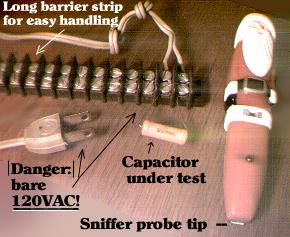
THE FOLLOWING CAN BE DANGEROUS AND DEADLY and should only be done by people experienced with handling high voltage electricity! Do this at your own risk!
I got one of those "powerline sniffers" for troubleshooting Xmas lights,
Home Depot (major hardware store) should have similar devices for
detecting the presence of powerline voltage on wires.
A non-contact device that lights an LED in the presence of high voltage AC.
An electrician's sniffing tool should work for this as well.
Assuming the cap in
question is rated for at least 200VDC (assuming you have 120V
powerlines!), connect temporarily, but
carefully!, across the powerline. Use a long barrier strip
and connect the power cord to a pair of terminals at one end,
and you can grab the other end reasonably safely.
Be careful you don't let the cap leads short to something! Use a clean uncluttered non-conductive work bench.
Then plug it in.
Use the sniffer on the leads
to see which is the hot side, and sniff the body to see if you still
get a hot indication. Reverse the cap leads (or reverse
the power cord's plug), sniff again. The
connection that gave a "hotter" indication on the body has the
outside foil connected to the lead going to the
hot side of the powerline. If you get an ambiguous result, the cap
may have foils from both leads exposed inside the insulated body.